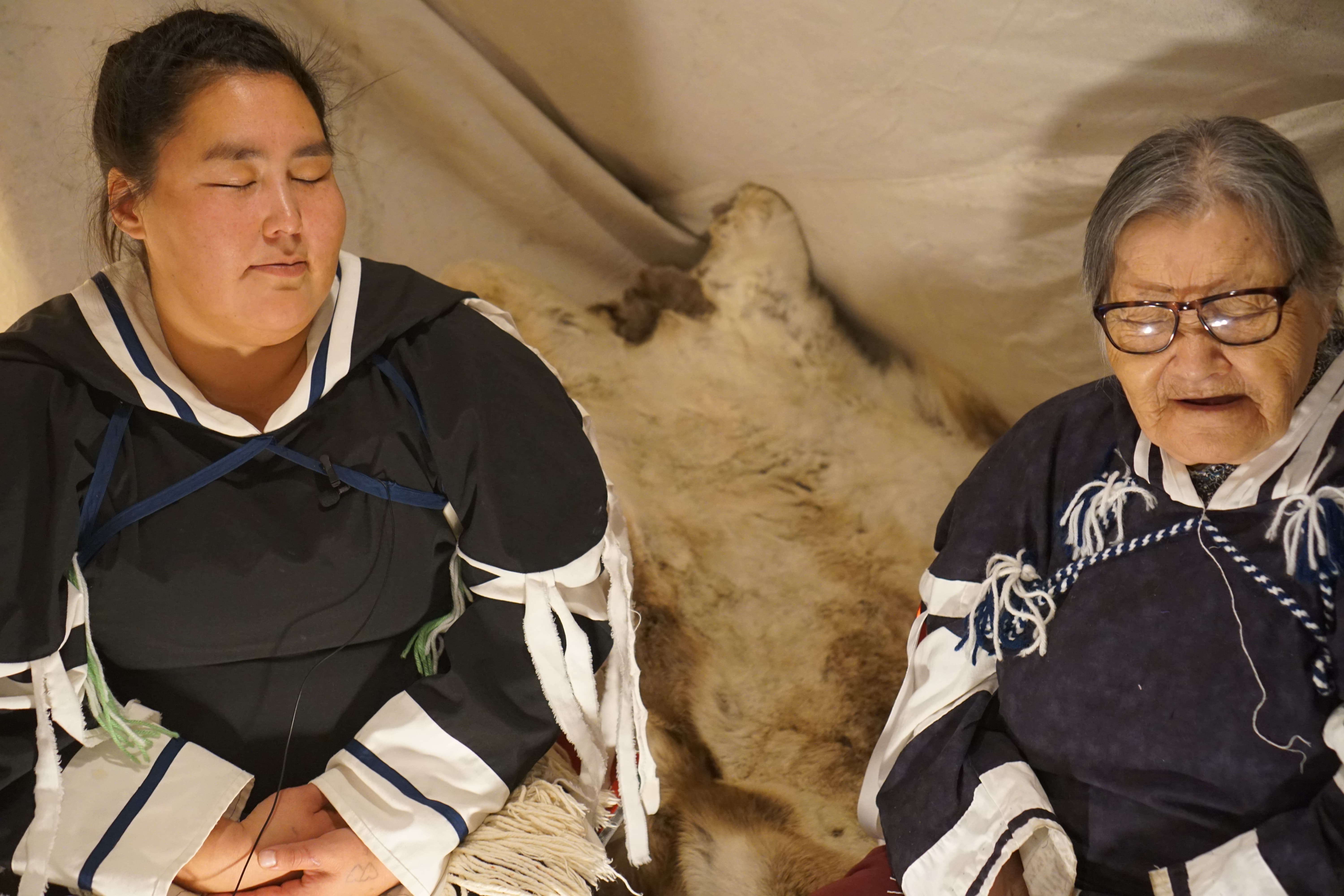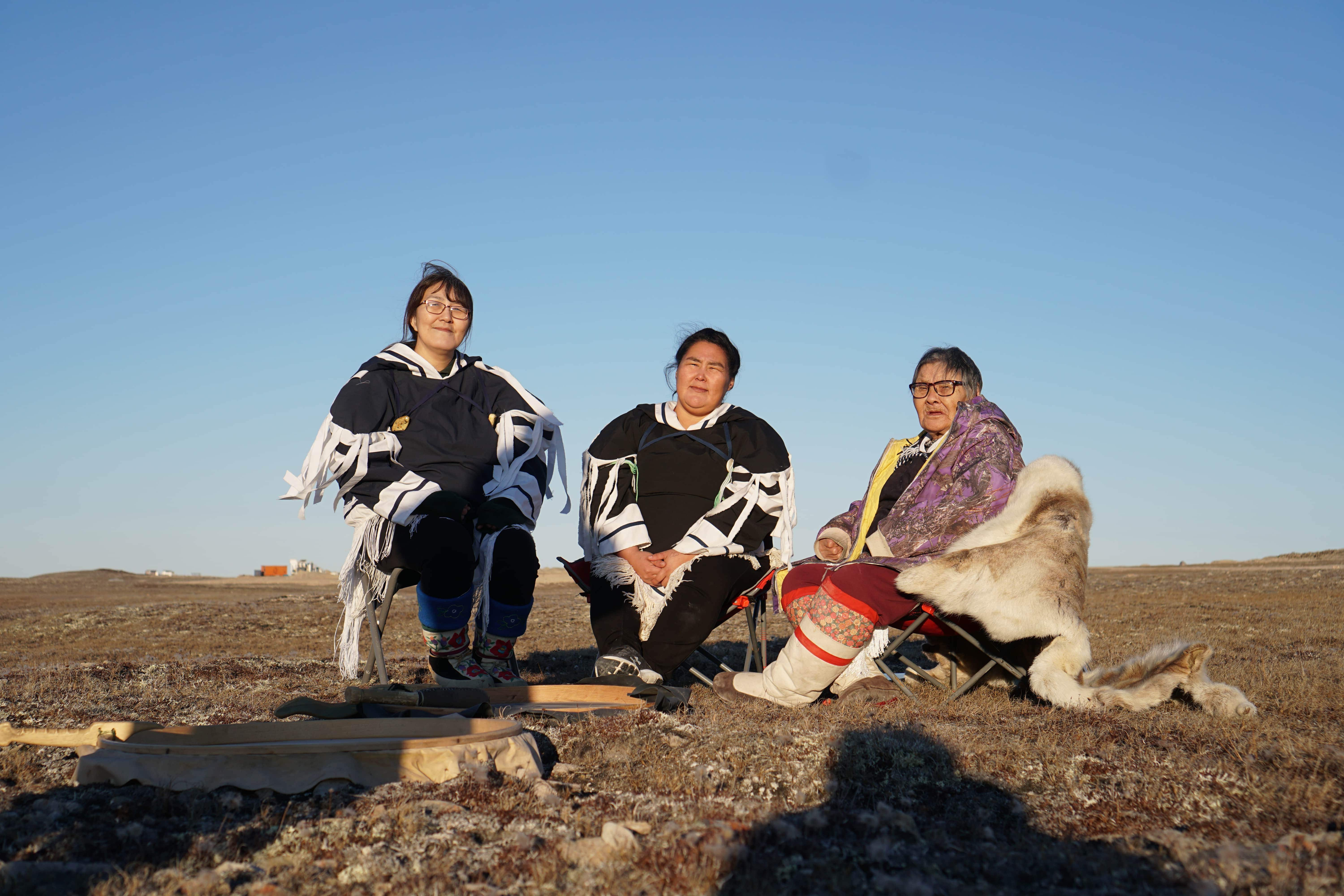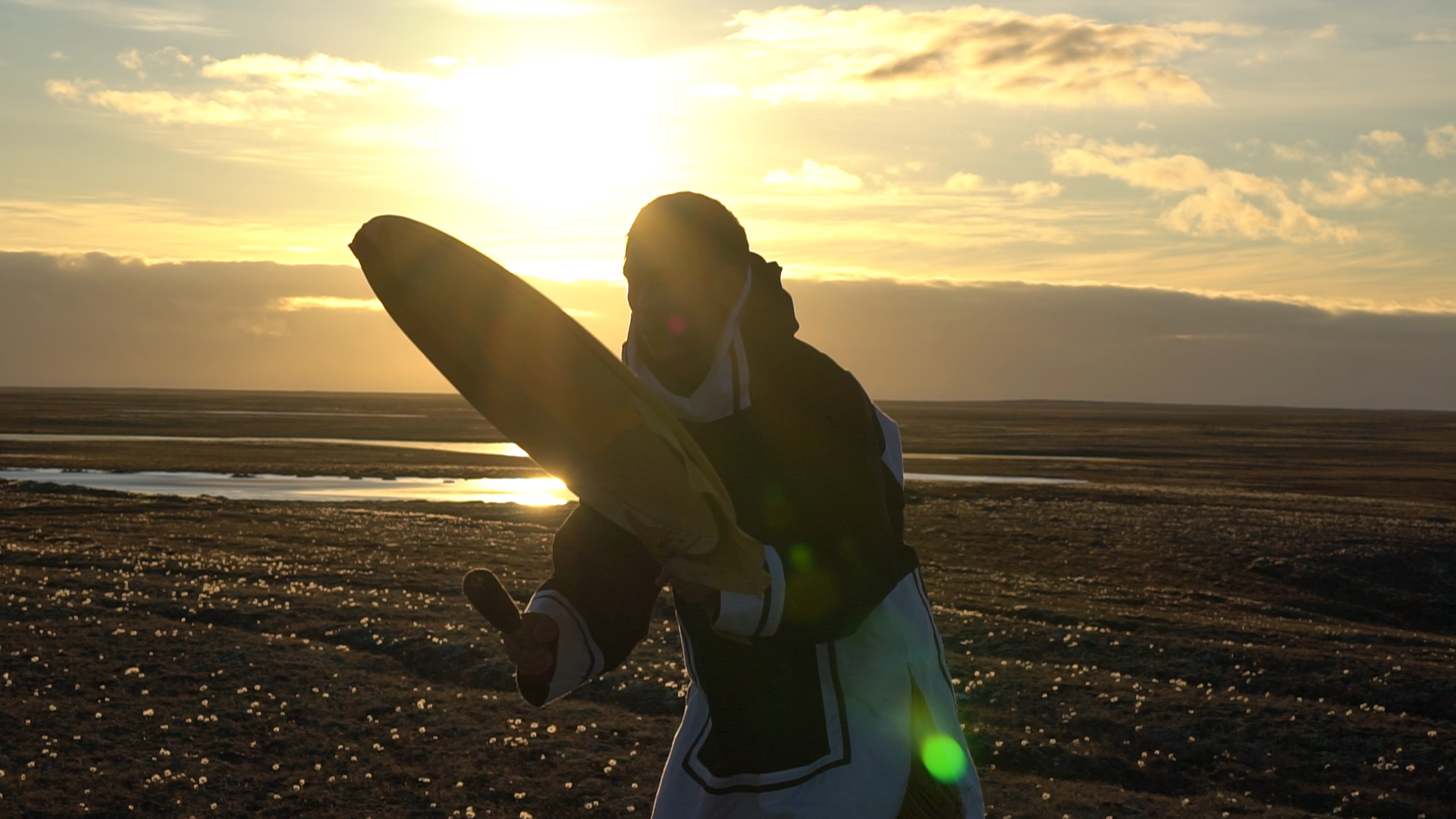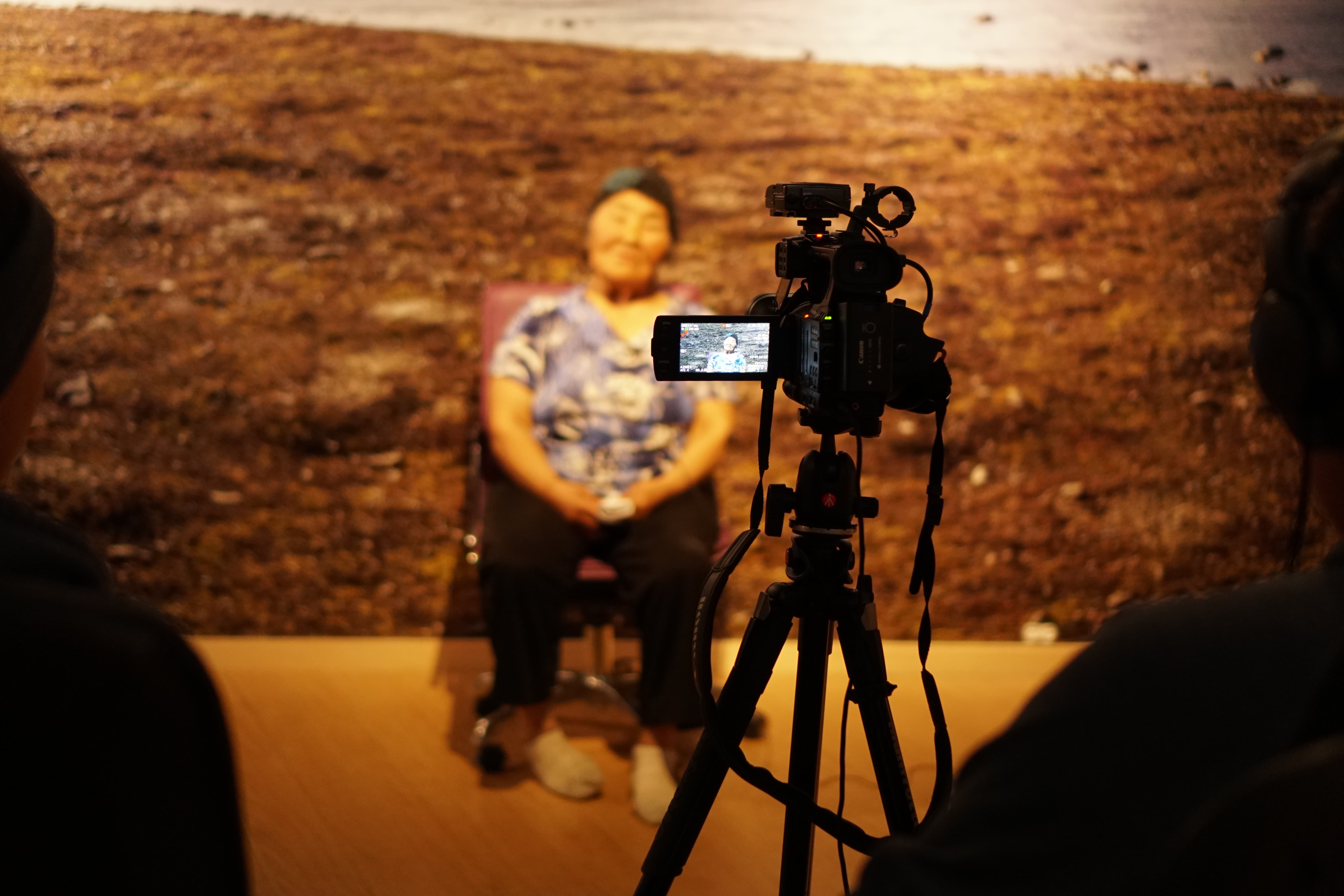Community co-creation: Difference between revisions
| (17 intermediate revisions by 2 users not shown) | |||
| Line 1: | Line 1: | ||
During the summer of 2021, my accommodation was the, what is referred to in the community of Gjoa Haven, ‘old arcade’ or the ‘blue house’. This blue house functioned as a launch pad for on-the-land sampling activities for multiple research projects due to its size and affordances for storage. It would also house several graduate and undergraduate students, including myself, that joined for the first part of the trip. Finally, it functioned as a meeting space where we would cook and eat together. There is power and heating in the building, but no facilities or windows. What it lacked in comfort however, it made up in opportunities to connect with people that the hotel did not as easily allow for. Knowing that we were based in the blue house, people would be passing by to pick up supplies and payments slips, or just to chat. | During the summer of 2021, my accommodation was the, what is referred to in the community of Gjoa Haven, ‘old arcade’ or the ‘blue house’. This blue house functioned as a launch pad for on-the-land sampling activities for multiple research projects due to its size and affordances for storage. It would also house several graduate and undergraduate students, including myself, that joined for the first part of the trip. Finally, it functioned as a meeting space where we would cook and eat together. There is power and heating in the building, but no facilities or windows. What it lacked in comfort however, it made up in opportunities to connect with people that the hotel did not as easily allow for. Knowing that we were based in the blue house, people would be passing by to pick up supplies and payments slips, or just to chat. | ||
[[File:Blue house pool.jpg|thumb|BearWatch PI Lougheed in the blue house playing pool]] | |||
<div class="next_choice">After most other students had left and returned back to the south, having the blue house available also made it much easier to coordinate audio-recordings, interviews, and other film-related activities.</div> | |||
=Throatsinging= | =Throatsinging= | ||
| Line 21: | Line 22: | ||
=Pihhiq & Drumdancing= | =Pihhiq & Drumdancing= | ||
I was also connected to Christina Porter, as another option for the video soundtrack. Christina is a teacher at the Gjoa Haven school and very involved with drumdancing in Gjoa Haven. Although she doesn’t dance a lot herself anymore, her daughter Aldina Porter and one of the young men we worked with a lot in town; Percy Iqualaq, do. Christina consulted us on the meaning of drumdancing and how these dances were often accompagnied with a "Pihhiq". A Pihhiq is a song that is connected to a specific well-respected hunter from the community. They are traditional songs, that describe the life or specific huntingstories of that hunter, and are sung by descendants of that hunter from memory. | I was also connected to Christina Porter by the Gjoa Haven HTA, as another option for the video soundtrack. Christina is a teacher at the Gjoa Haven school and very involved with drumdancing in Gjoa Haven. Although she doesn’t dance a lot herself anymore, her daughter Aldina Porter and one of the young men we worked with a lot in town; Percy Iqualaq, do. Christina consulted us on the meaning of drumdancing and how these dances were often accompagnied with a "Pihhiq". A Pihhiq is a song that is connected to a specific well-respected hunter from the community. They are traditional songs, that describe the life or specific huntingstories of that hunter, and are sung by descendants of that hunter from memory. | ||
<HTML> | |||
<iframe width="560" height="315" src="https://www.youtube.com/embed/xBCzPuIq2vk?si=KN4U6i494v6WeXXw" title="YouTube video player" frameborder="0" allow="accelerometer; autoplay; clipboard-write; encrypted-media; gyroscope; picture-in-picture; web-share" referrerpolicy="strict-origin-when-cross-origin" allowfullscreen></iframe> | <iframe width="560" height="315" src="https://www.youtube.com/embed/xBCzPuIq2vk?si=KN4U6i494v6WeXXw" title="YouTube video player" frameborder="0" allow="accelerometer; autoplay; clipboard-write; encrypted-media; gyroscope; picture-in-picture; web-share" referrerpolicy="strict-origin-when-cross-origin" allowfullscreen></iframe> | ||
</html> | |||
Christina helped us gather drums, traditional drumdancing garbs and called three women that would occasionally sing together; Mary Iqiruak, Angelina Aglukkaq and Holle Porter. First we audio-recorded the Pihhiq and the drumdance inside the blue house to make sure that we would have an audiorecording of decent quality. We recorded both visual as well as audio footage of the women singing the Pihhiq song inside a canvas tent that we had set up in the blue house. As they were singing, the three women closed their eyes. After the first take, I asked them why they had done so. They commented that they could just ‘see’ the land that they were singing about when they would close their eyes, indicating a clear connection between the Pihhiq and the land they’re singing about. | Christina helped us gather drums, traditional drumdancing garbs and called three women that would occasionally sing together; Mary Iqiruak, Angelina Aglukkaq and Holle Porter. First we audio-recorded the Pihhiq and the drumdance inside the blue house to make sure that we would have an audiorecording of decent quality. We recorded both visual as well as audio footage of the women singing the Pihhiq song inside a canvas tent that we had set up in the blue house. As they were singing, the three women closed their eyes. After the first take, I asked them why they had done so. They commented that they could just ‘see’ the land that they were singing about when they would close their eyes, indicating a clear connection between the Pihhiq and the land they’re singing about. | ||
[[File:Pihhiq.jpg|thumb|Angeline and Mary singing a Pihhiq (photograph by de Wildt, 2021)]] | |||
[[File:Holle, Angeline and Mary singing a Pihhiq (photograph by de Wildt, 2021) sm (1).jpg|thumb|Holle, Angeline and Mary singing a Pihhiq (photograph by de Wildt, 2021)]] | |||
[[File:Percy3 (sm).jpg|thumb|Percy Ikuallaq drumdancing (photograph by de Wildt, 2021)]] | |||
After having filmed the three women singing in the tent we drove them, Christina and the two drumdancers out to the land around the community, close to where some people have their cabins and stayed there for a couple of hours. We filmed Percy and Aldina as they were drumdancing, and the women as they were singing their Pihhiq over and over again. The women were enjoying themselves so much they were not paying attention to whether they were being filmed or not, and just continued singing as long as they enjoyed themselves. This was demonstrated by the occurrence of them ending their song and chatting amongst each other at the exact moment they emerged in the frame during a technically complicated drone shot. Mary commented, like Kathy had, after filming on the land, that it had been a very long time ago that she had been able to go out on the land, and that she had "so much fun"! More than two years later, during the evaluation of the final BearWatch workshops, she recalled how she had initially felt a little intimidated by the whole set-up of singing in the tent, but how much she had enjoyed the day of filming and how grateful she was for the opportunity to sing with the other women and the dancers out on the land. | After having filmed the three women singing in the tent we drove them, Christina and the two drumdancers out to the land around the community, close to where some people have their cabins and stayed there for a couple of hours. We filmed Percy and Aldina as they were drumdancing, and the women as they were singing their Pihhiq over and over again. The women were enjoying themselves so much they were not paying attention to whether they were being filmed or not, and just continued singing as long as they enjoyed themselves. This was demonstrated by the occurrence of them ending their song and chatting amongst each other at the exact moment they emerged in the frame during a technically complicated drone shot. Mary commented, like Kathy had, after filming on the land, that it had been a very long time ago that she had been able to go out on the land, and that she had "so much fun"! More than two years later, during the evaluation of the final BearWatch workshops, she recalled how she had initially felt a little intimidated by the whole set-up of singing in the tent, but how much she had enjoyed the day of filming and how grateful she was for the opportunity to sing with the other women and the dancers out on the land. | ||
| Line 31: | Line 38: | ||
=Storytelling at the Heritage Centre= | =Storytelling at the Heritage Centre= | ||
The conversations I had during the filming of the throatsinging and Pihhiq singing, made it clear that the value of filming such traditional practices, extended beyond the original purposes of recording such practices. Although these videos and audio-recordings could indeed be used as a soundtrack to the "Voices of Thunder" documentary, or used as part of an advocacy strategy to generate recognition for the impacts of polar bear quota reductions - it also became clear that the process of filming these practices, for example on the land, in itself, provided possibilities and conditions for people of different generations to come together and practice their traditional songs and dances in ways that are not always possible. | |||
The possibilities for the younger generation to learn from older generations, became clear at several moments during the preparation and filming of the drumdancing and singing of the pihhiq- and also later at the community screenings of the films- when the elders explained certain moments of the pihhiq and drumdancing. | |||
Understanding the material possibilities for knowledge renewal that filmmaking in the community could offer beyond merely the final product, resulted in the organization of a filmmaking workshop and storytelling session at the Netsilik Heritage Center. We hired a young Gjoa Haven-based filmmaker: Barbara Qitsualik to facilitate a filmmaking workshop for community youth. She trained three other youth to operate a film-camera that we rented from the Natsilik Heritage Center, for two afternoons. On the third day, we brought in four elders and two people of middle age to share polar bear stories and legends in the Netsilik Heritage Center. We also hired an interpreter, so that when necessary stories and instructions could be translated between people and generations. The recordings were passed to the Netsilik Heritage Center. | |||
[[File:Barbara Okpik instructing (photograph by de Wildt., 2021).jpg|thumb|Barbara Okpik instructing (photograph by de Wildt., 2021)]] | |||
[[File:Recording legends at the heritage centre (photograph by de Wildt, 2021).jpg|thumb|Recording legends at the heritage centre (photograph by de Wildt, 2021)]] | |||
<span class="redirective invitation link" data-page-title="Drinking Coffee" data-section-id="0" data-encounter-type="invitation">[[Drinking Coffee|Invitation: Drinking Coffee]]</span> | <span class="redirective invitation link" data-page-title="Drinking Coffee" data-section-id="0" data-encounter-type="invitation">[[Drinking Coffee|Invitation: Drinking Coffee]]</span> | ||
Latest revision as of 14:54, 16 August 2025
During the summer of 2021, my accommodation was the, what is referred to in the community of Gjoa Haven, ‘old arcade’ or the ‘blue house’. This blue house functioned as a launch pad for on-the-land sampling activities for multiple research projects due to its size and affordances for storage. It would also house several graduate and undergraduate students, including myself, that joined for the first part of the trip. Finally, it functioned as a meeting space where we would cook and eat together. There is power and heating in the building, but no facilities or windows. What it lacked in comfort however, it made up in opportunities to connect with people that the hotel did not as easily allow for. Knowing that we were based in the blue house, people would be passing by to pick up supplies and payments slips, or just to chat.

Throatsinging[edit]
During the storyboarding and artwork phase of filmmaking, we had also started to discuss what kind of soundtrack the film would need. Soon, I was pointed towards Janet Aglukkaq, who had been taught the technique of throatsinging by her mom? and continues to teach others by practice. I met up with Janet and her friend Kathy Okpik, at Kathy’s house to record and film their singing. The choice to film this, rather than only audio-record it, was initially a strategic one; filming would mean additional video content that could generate attention around the "Voices of Thunder". Very quickly however, it became clear that filming would also provide a reason to come together and sing, a valuable purpose in its own right.
Turning the recording of their throatsinging into a music video allowed us to get creative in coming up with a little storyline. Only having a couple of hours available that day to finish the filming, we decided on a very simple story-arch of two friends visiting each other and throatsinging together. We staged some shots of how they would meet: Kathy making coffee, Janet entering the house, and the friends greeting each other.
As they start singing, the camera zooms in, as the frame fades into a white-out and reappears as the two of them singing on the land surrounding Gjoa Haven. To shoot the scene of Kathy and Janet throatsinging on the land, we of course had to travel outside of the hamlet, which caused considerable excitement for both women and Serge, Kathy’s younger brother, who joined us. It was through our conversations between filming and driving outside the community to find a good location to film the second part of the video, that I learnt how many community members would not have the resources (like vehicles or money) to go outside of the hamlet, onto the land.
Shooting this video provided an opportunity to be out on the land and practice the tradition of throatsinging. Something that, even though it took us only 15 minutes to drive up to the road where we were filming, can be seen as a privilege that is not accessible to everyone in the community.
Pihhiq & Drumdancing[edit]
I was also connected to Christina Porter by the Gjoa Haven HTA, as another option for the video soundtrack. Christina is a teacher at the Gjoa Haven school and very involved with drumdancing in Gjoa Haven. Although she doesn’t dance a lot herself anymore, her daughter Aldina Porter and one of the young men we worked with a lot in town; Percy Iqualaq, do. Christina consulted us on the meaning of drumdancing and how these dances were often accompagnied with a "Pihhiq". A Pihhiq is a song that is connected to a specific well-respected hunter from the community. They are traditional songs, that describe the life or specific huntingstories of that hunter, and are sung by descendants of that hunter from memory.
Christina helped us gather drums, traditional drumdancing garbs and called three women that would occasionally sing together; Mary Iqiruak, Angelina Aglukkaq and Holle Porter. First we audio-recorded the Pihhiq and the drumdance inside the blue house to make sure that we would have an audiorecording of decent quality. We recorded both visual as well as audio footage of the women singing the Pihhiq song inside a canvas tent that we had set up in the blue house. As they were singing, the three women closed their eyes. After the first take, I asked them why they had done so. They commented that they could just ‘see’ the land that they were singing about when they would close their eyes, indicating a clear connection between the Pihhiq and the land they’re singing about.



After having filmed the three women singing in the tent we drove them, Christina and the two drumdancers out to the land around the community, close to where some people have their cabins and stayed there for a couple of hours. We filmed Percy and Aldina as they were drumdancing, and the women as they were singing their Pihhiq over and over again. The women were enjoying themselves so much they were not paying attention to whether they were being filmed or not, and just continued singing as long as they enjoyed themselves. This was demonstrated by the occurrence of them ending their song and chatting amongst each other at the exact moment they emerged in the frame during a technically complicated drone shot. Mary commented, like Kathy had, after filming on the land, that it had been a very long time ago that she had been able to go out on the land, and that she had "so much fun"! More than two years later, during the evaluation of the final BearWatch workshops, she recalled how she had initially felt a little intimidated by the whole set-up of singing in the tent, but how much she had enjoyed the day of filming and how grateful she was for the opportunity to sing with the other women and the dancers out on the land.
Storytelling at the Heritage Centre[edit]
The conversations I had during the filming of the throatsinging and Pihhiq singing, made it clear that the value of filming such traditional practices, extended beyond the original purposes of recording such practices. Although these videos and audio-recordings could indeed be used as a soundtrack to the "Voices of Thunder" documentary, or used as part of an advocacy strategy to generate recognition for the impacts of polar bear quota reductions - it also became clear that the process of filming these practices, for example on the land, in itself, provided possibilities and conditions for people of different generations to come together and practice their traditional songs and dances in ways that are not always possible.
The possibilities for the younger generation to learn from older generations, became clear at several moments during the preparation and filming of the drumdancing and singing of the pihhiq- and also later at the community screenings of the films- when the elders explained certain moments of the pihhiq and drumdancing.
Understanding the material possibilities for knowledge renewal that filmmaking in the community could offer beyond merely the final product, resulted in the organization of a filmmaking workshop and storytelling session at the Netsilik Heritage Center. We hired a young Gjoa Haven-based filmmaker: Barbara Qitsualik to facilitate a filmmaking workshop for community youth. She trained three other youth to operate a film-camera that we rented from the Natsilik Heritage Center, for two afternoons. On the third day, we brought in four elders and two people of middle age to share polar bear stories and legends in the Netsilik Heritage Center. We also hired an interpreter, so that when necessary stories and instructions could be translated between people and generations. The recordings were passed to the Netsilik Heritage Center.


